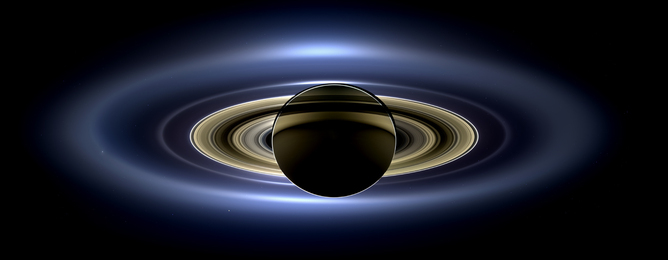Age of Saturn's Rings Revealed

Saturn's iconic rings likely formed about 4.4 billion years ago, shortly after the planet itself took shape, a new study suggests.
The origin of Saturn's ring system has long been the subject of debate, with some researchers arguing that it's a relatively young structure and others holding that it coalesced long ago, at roughly the same time as the gas giant's many satellites.
The new study, conducted using data gathered by NASA's Saturn-orbiting Cassini spacecraft, strongly supports the latter scenario, researchers said here Tuesday (Dec. 10) at the annual meeting of the American Geophysical Union.
Image : A new mosaic of Saturn and rings made by Cassini spacecraft, brightened version with contrast and color enhanced. Image released Nov. 12, 2013. Credit: NASA/JPL-Caltech/SSI.
Easy Math Editor
This discussion board is a place to discuss our Daily Challenges and the math and science related to those challenges. Explanations are more than just a solution — they should explain the steps and thinking strategies that you used to obtain the solution. Comments should further the discussion of math and science.
When posting on Brilliant:
*italics*or_italics_**bold**or__bold__paragraph 1
paragraph 2
[example link](https://brilliant.org)> This is a quote# I indented these lines # 4 spaces, and now they show # up as a code block. print "hello world"\(...\)or\[...\]to ensure proper formatting.2 \times 32^{34}a_{i-1}\frac{2}{3}\sqrt{2}\sum_{i=1}^3\sin \theta\boxed{123}Comments
It amazes me how we can get such accurate information, for something that is so far away and created so long ago.
Do you have a link to the article? I would like to read more about it.
This natural-color view of Saturn was made possible by a rare, near-polar orbit Oct. 10, 2013 that allowed NASA's Cassini spacecraft to look down upon the sunlit northern hemisphere.
When Cassini arrived in 2004, Saturn's wintry northern hemisphere sported a bluish hue. Nine years later, the now-summery northern hemisphere has taken on golden tones. At the pole, the mysterious hexagon weather pattern remains bluish.
Similar, highly-inclined orbits will dominate toward the mission's end in 2016-2017, and will allow unprecedented studies of Saturn' poles, rings and magnetic environment.
The vertical position of rings of saturn is also because of it's collision with a meteoriod ,in size equal to earth at 35degree .The collision forced saturn to turn 90degree from it's original position.
Saturn's iconic rings likely formed about 4.4 billion years ago, shortly after the planet itself took